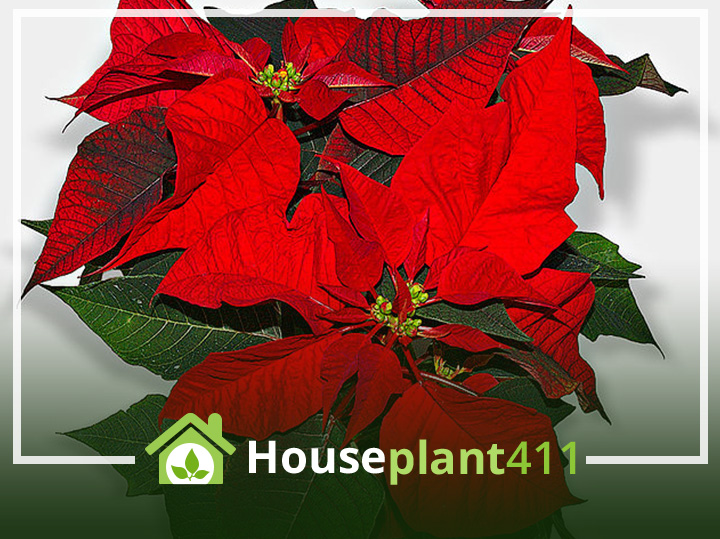History
A Poinsettia plant (Euphorbia pulcherima),native to Mexico, is the most popular indoor flowering plant sold in the U.S. even though it is only available six weeks of the year. It has become a well-known symbol of the Christmas season. Joel Roberts Poinsett, the first US ambassador to Mexico, and a botanist, found poinsettias growing in Taxco, Mexico and had them sent back to his home in South Carolina.
Description
The colorful parts of a Poinsettia plant are really modified leaves called bracts. Many people mistakenly think the bracts are the flower petals of the plant. These bracts are the beautiful part of the plant, but they are not the flowers. The real flowers are quite inconsequential and are located inside the small yellow part of the poinsettia called a cyathia. There is a cyathia in the center of each group of bracts. Selecting the right poinsettia is the key to having a plant that stays colorful and beautiful the entire holiday season. Ideally there should be green leaves all the way to the soil line. The plant should be well balanced and not top heavy. The “real” tiny, yellow flowers should be barely open, and there should be no pollen on the plant.
Poinsettia Sizes, Shapes, and Colors
There are many different sizes and shapes of poinsettias available on the market today. Poinsettias can be found in 4’, 6,’ 8,’ 10” pots, and hanging baskets. The shape of a poinsettia plant can be straight up with be 3-4 stems each having one large poinsettia per stem. However, the most popular shape today is the pinched variety. The growing tips are pinched back which encourages a bushy plant with multiple flowers and side branches. Poinsettias are also available as large bushes, and topiaries. The original poinsettia was a bright vibrant red. Today poinsettias can be found in red, pink, white, salmon, Jingle Bells (red with pink splashes), Marble, Ice Punch (white center and deep red leaves), Marco Polo (light salmon with a touch of frost), and about 30 other speckled and marbled varieties. Whether you chose the ever-popular red poinsettia or any of the many new colors this is a wonderful holiday.
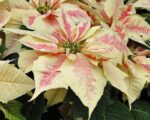
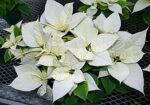
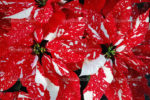
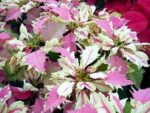
How to Get a Poinsettia to Flower
Poinsettias are photoperiodic plants which mean they start to develop blooms when days are short, and nights are long. A poinsettia needs 8-10 weeks of total darkness, 12-14 hours a day, during late October and November to produce flower buds and have their leaves (bracts) turn color around Christmas.
Late Spring/ Summer
The colorful leaves (bracts) on a poinsettia may last for several weeks or even months after the Christmas season. With bright light, proper watering side shoots will develop below the bracts. Once the side shoots develop and to have a nicely plant the following year, remove old flowers still on the plant in February or March. In early spring it is time to prune your poinsettia. Cut the stems back to 4″- 5″ above the soil line. Be sure to leave a few green leaves on each of the stems; new growth develops from buds found in the leaf axils along the stems. Keep your poinsettia in a bright, sunny, cool area where the temperature is between 60°–70°F (15.6°– 21.1°C) and fertilize once a month until December. Use a balanced plant food diluted to 1/2 the recommended strength.
Between June and July, it is time to prune again. Cut all of the stems back to about 4” and be sure to leave a few leaves on each stem. Pruning is very important because it encourages the plant become full and bushy and produce more flowers during the Christmas season. Around August, pinch off the growing tips on the stems one more time.
Fall/ Early Winter
For the poinsettia bracts to turn color again, at the end of September you must move the plant to a place where it will be in complete darkness for 12-15 hours a day. Follow this routine until the leaves start to turn color in early December. The temperature should be between 60°- 70° F (15.6°- 21.1°C). Night temperatures above 70°F (21.1°C) may delay or prevent the plant from turning color. Hopefully you’ll have a beautiful plant in time for Christmas.
Is a Poinsettia Poisonous?
Poinsettias, despite all rumors, are not considered to be a poisonous plant. A pet or child would have to eat a large amount of the plant to become ill. A mild, itchy rash may develop if the milky sap of the plant gets on your skin. You can read more about common houseplants that are poisonous in my book Don’t Feed me to Your Cat: A Guide to Poisonous Houseplants .
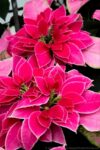
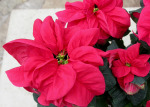
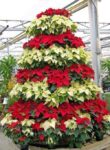
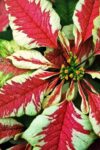
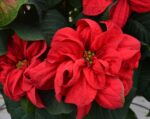
Plant Care
Light
Light for a poinsettia plant: A poinsettia plant needs very bright, indirect light but no direct sun from January to late September. The light from a north- facing window is not enough. If you put your poinsettia plant close to a window, be sure none of the leaves touch the glass or the cold will damage them. At the end of September, move your poinsettia to a location where it will be in total darkness for 12-15 hours a day. Keep the plant in this location until the leaves begin to to turn color in December. The light from a north- facing window is not enough. If you put your poinsettia plant close to a window, be sure none of the leaves touch the glass or the cold will damage them.
Water
How to water a poinsettia plant: A poinsettia plant is a member of the Euphorbia family and like been theory side. Allow the top 50% of the soil to dry out before you water to prevent root rot. Over-watering a poinsettia causes green leaves to fall off, leaving bare stems topped by a few colorful bracts. Severe under-watering, in which a poinsettia plant badly droops, results in both green and colored leaves dropping off. Avoid getting the leaves of a poinsettia plant wet when watering; water drops cause unsightly white marks on the flowers and leaves.
Fertilizer
How to fertilize a poinsettia plant: Feed a poinsettia monthly from late February until December. Use a balanced plant food diluted to 1/2 the recommended strength.
Temperature
Best temperature for a poinsettia plant: Temperature is a very important factor in poinsettia plant care. A poinsettia plants lasts longer and look better when the temperature is between 65°-70°F (18.3°-21.1°C) during the day and around 60°F (15.6°C) at night. Temperatures that are too hot or too cold damage leaves and may cause leaf drop. Keep a poinsettia plant away from drafty doors and windows, fireplaces, heaters, and the tops of appliances that give off heat.
Humidity
How much humidity for a poinsettia plant: A poinsettia plant does well in basic household humidity.
Flowering
How to get a poinsettia to flower again: Please see completer instructions below.
Pests
Poinsettia plant pests: Plant pests that can be problem for a poinsettia plant are: whiteflies, fungus gnats, mealy bugs, and spider mites. Read how to identify and treat these plant pests in the Glossary of the website.
Diseases
Poinsettia plant diseases: Avoid over- watering and keep the leaves of a poinsettia plant dry to prevent plant diseases.
Soil
Proper soil for a poinsettia plant: Use a high quality, sterile, quick-draining, acidic potting soil for a poinsettia plant.
Pot Size
Best pot sizer a poinsettia plant: Poinsettia plants can be found in 4″-14″pots. The container should only be 2″-4″ larger than the root ball of the plant and must have drip holes in the bottom of the pot so excess water can escape. Never allow the plant to sit in the excess water for more than 10 minutes. If the pot is too large, the soil stays wet too long, and the plant develops root rot.
Propagation
How to propagate a poinsettia: A poinsettia is propagated using 3″-4″stem cuttings from healthy new growth. Do not use old stems that have flowered the previous year for propagation. The cuttings should have several matures leaves on them. You can read a complete guide on how to propagate a plant using stem cuttings in the Glossary of the website.
Special Occasion
A poinsettia plant is a perfect Christmas gift.
Poisonous Plant Info
A poinsettia plant is not toxic to small children, cats, or dogs. Despite all the rumors, the plant causes minor discomfort if a few leaves are eaten. If quite a bit of the plant is ingested, some vomiting, drooling in pets, or sometimes diarrhea may be occur. It’s the white, milky sap of a poinsettia plant that can cause redness, swelling, and itchiness if it gets on the skin, especially if someone is allergic to latex.
FAQ
Poinsettias come in many colors, red, white, pink, salmon, marble, red & white mix, speckled, but not blue & purple. Poinsettias that are blue and purple have been spray painted with floral paint to get the desired color or injected with a blue dye.
Poinsettia Plants lose both green leaves and colorful bracts if the soil is too wet. Allow the top 50% of the soil to dry out before watering a Poinsettia Plant. Poinsettias should never totally dry out, but over- watering a Poinsettia Plant is worse than under- watering a Poinsettia Plant.
Sitting Poinsettia Plants in water is a bad idea. I would either move your Poinsettias to a new location where it is easier to water them or use a product called DriWater, a sausage like tube of gel that you cut open and lay on the wet soil. DriWater slowly provides moisture to the plant for several weeks. You can read more about Dri-Water in the Glossary of the website.
The little plant pests flying around your Poinsettia Plant are white flies. I don’t recommend spraying anything on the leaves of a Poinsettia Plant since they are so easily damaged. Place some Yellow Sticky Insect Cards on top of the soil in the plant. Keep replacing the insect cards as they get covered with the White Flies. I’d leave an insect card in the plant permanently to prevent more White Flies.
The leaves of your Poinsettia Plant are turning black because they are touching the window and being damaged by the cold. The bright light is perfect for a Poinsettia, but you have to move your plant away from all drafts, heaters, and anything hot or cold that might touch the leaves.

